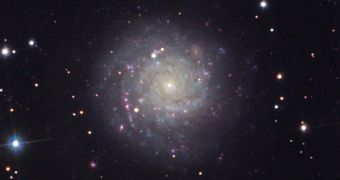Nearly 50 years ago, a stellar explosion captured by telescopes posed a serious dilemma to astronomers trying to determine what type of cosmic event this was. Even now, so many years after the star disappeared, experts cannot agree on what it was.
Two main camps were formed to explain the cosmic event, with one of them arguing that the object, called SN 1961V, was a special type of supernova, while the other said it was an energetic eruption of a Luminous Blue Variable (LBV) star.
Famous Swiss astronomer Fritz Zwicky called the object a supernova impostor, and proposed that it be classified as a type V supernova, Universe Today reports.
Located in the face-on spiral galaxy NGC 1058, the star that generated the odd event exploded in a very unusual manner. It took several months to reach its full brightness after it exploded.
After maintaining a peak brightness for three years, it slowly began to decline, before fading away. These traits do not allow for it to be classified as a supernova, but are too strong for a LVB explosion.
One of the main directions of research in making sense of the event was looking at all available data on how the star looked before it blew up. Several image archives were available for reference.
The most interesting thing the astronomers noted was that the space body had an absolute magnitude of nearly -12. For comparison, Eta Carinae, one of the heaviest star in the known Universe, has an absolute magnitude of only -5.5.
Experts then inferred in early studies that the star must have had as much as 2,000 solar masses, which made it incredibly massive. Later investigations refined the number, showing the precursor star was only 100 to 200 times heavier than the Sun.
Researchers could not classify the explosion as a supernova because it did not produce a neutron star or black hole, as expected of such cosmic event. On the other hand, the original star disappeared after the explosion, which means that the event was not only an eruption.
Astronomers have not turned to the Spitzer Space telescope for help. Though usually incapable of imaging single stars, the observatory can peer into the layer of dust that surrounds SN 1961V's remains, and determine via analyzing infrared sources whether a star was left behind following the explosion.
The work is being conducted by experts at the Ohio State University, who are led by Christopher Kochanek. Thus far, astronomers could not find any IR source to match a potential stellar remnant fo the peculiar event.
The team says that it will continue its work until it will be able to say for sure what happened to the object.

 14 DAY TRIAL //
14 DAY TRIAL //